Colorful lights twinkle everywhere during the holiday season, including up above in some remarkably tinted double stars. Find out what makes them so alluring.
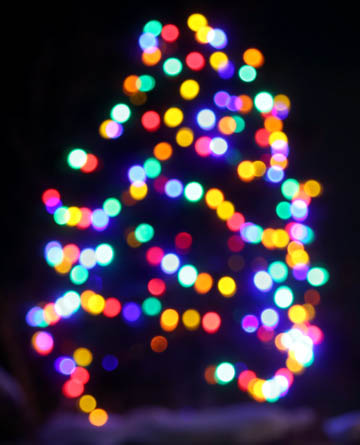
Bob King
Stars show different colors depending on their temperature. Red ones are cooler, orange ones hotter, and blue hotter still. Every star emits light of all wavelengths, but cooler ones radiate more of their light in the red end of the spectrum compared to stars like the Sun with a peak output in the yellow-green. It's no coincidence that that's also the same spectral zone in which are eyes are most sensitive.
Now, pair two different colored stars in a binary system, and the human brain works a strange magic. If the brighter of the two is red or orange colored, the fainter secondary, if it's white, will take on the complementary color of the primary or in this case, blue or green.
What's more, the pseudo-blue star in turn helps to further enhance the color of the primary, making color perception an organic experience in which the observer is intimately involved.
Take Albireo. Some observers see gold and blue, others yellow and white. Based on the spectral classification K2II (warm-toned) and B8 (close to pure white) for the secondary, it would seem that for many observers, the complementary color effect is at play.
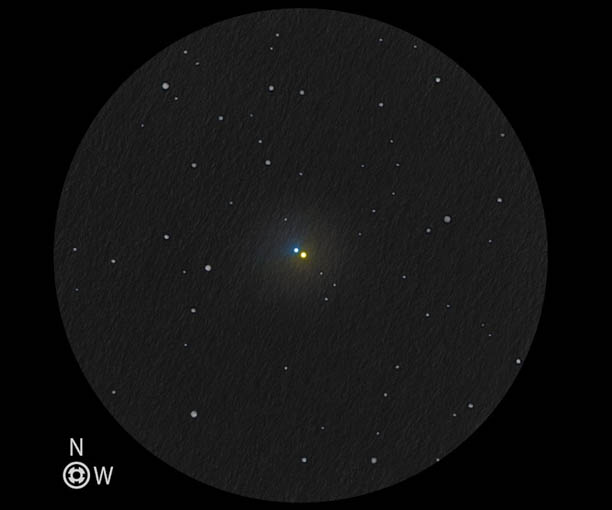
Jeremy Perez
The only way to tell fact from fancy is to hide each star in turn and examine them separately. When I tried this the other evening, I was surprised at how the secondary lost its familiar blue hue, though the primary still glowed golden.
Next come the doubles where each star really does have a distinctly different hue based upon its spectral type. These may appear more genuinely colored visually, but with some, the complementary color effect can magnify their difference even more.
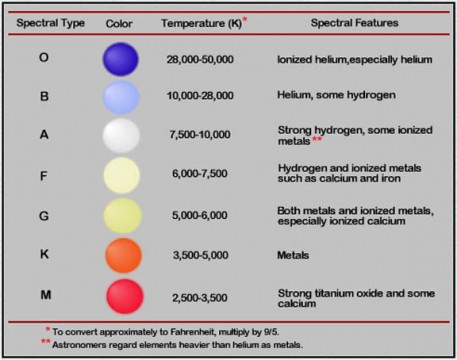
Eugene R. Zizka
Many amateurs seek out or happily stumble upon colorful double stars, whether those colors are "fake" or real. Red stars in particular are high on many observers' lists, as are the even rarer blue-white suns. Color adds beauty, character and a certain excitement to double star observing. We delight in contrasting colored light otherwise why our fascination with stained glass and rainbows?
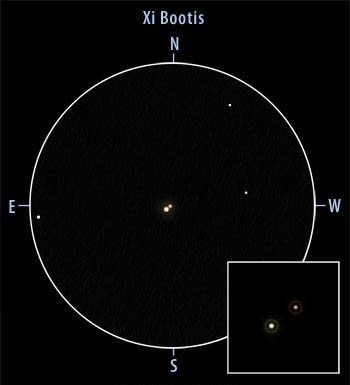
Jeremy Perez
To feed the color beast within, I've prepared a list of double stars that include those with true color contrast based on spectral type as well as those with complementary color contrast. I've included the classifications — OBAFGKM — to help you determine the color difference of each double using a method Sky & Telescope's Alan Adler employed a decade ago.
Alder compared each star's spectral class. If the stars were a single letter apart, as in G and K, the color difference between them was equal to 1. Gamma (γ) Andromedae (Almach) with a B8 class primary and K3 secondary, has a spread of 3.5, making it one of the more colorful doubles. The greater the number, the more strongly contrasting the components. If you notice a strong color difference and the spectral types don't indicate one, consider yourself a happy victim of spurious color!
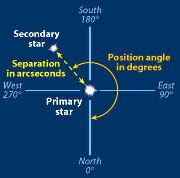
Sky & Telescope
As a general rule, O stars offer a hint of blue; B and A appear white; F and G look yellow (pale yellow on the F end); and K and M shine orange and ruddy-orange respectively. Numbers follow each letter from 0 to 9; the higher the number, the closer the star is to the next cooler class. In the table below, the spectral class of the primary is given first.
About magnification. For most of the listed doubles, low magnification (64× for me) worked well, but in the case where the two stars were close, I increased that to 124× to better separate the components and distinguish individual colors. One of the most interesting and unexpected results of my observations was that I could intensify the complementary color of a white companion star by keeping most of my attention on the primary star while still taking in the secondary. If instead I focused on the white secondary, its color would vanish. Try it and see how it works for you!
| 22 Contrasting Color Double Stars | |||||||||
| Star | R.A. Dec. |
Mags. | Sep. | P.A. | Color difference |
Spec. Class | |||
| η Cas | 00h 49m | +57° 49' | 3.5 | 7.2 | 13" | 317° | 1.7 | G0, K7 | |
| 1 Ari | 01h 50m | +22° 16' | 5.9 | 7.2 | 2.9" | 164° | 3.5 | K1, A6 | |
| γ And | 02h 04m | +42° 20' | 2.1 | 4.8 | 9.8" | 64° | 3.5 | K3, B8 | |
| ι Tri = 6 Tri | 02h 12m | +30° 18' | 5.3 | 6.7 | 4" | 69° | 1 | G5, F5 | |
| η Per | 02h 51m | +55° 54' | 3.8 | 8.5 | 28" | 301° | 3 | K3, A3 | |
| 32 Eri | 03h 54m | –02° 57' | 4.8 | 5.9 | 7" | 254° | 2.6 | G8, A2 | |
| ρ Ori | 05h 13m | +02° 52' | 4.6 | 8.5 | 7" | 64° | 1.7 | K3, F7 | |
| 14 Aur | 05h 15m | +32° 41' | 5.0 | 7.4 | 15" | 226° | 0.4 | A9, F3 | |
| ι Ori | 05h 35m | +05° 57' | 2.9 | 7.0 | 10.9" | 142° | 0.2 | O9, B1 | |
| γ Lep | 05h 44m | –22° 27' | 3.6 | 6.3 | 97" | 350° | 1.6 | F6, K2 | |
| h3945 CMa | 07h 17m | –23° 19' | 5.0 | 5.8 | 26.8" | 52° | 2.0 | K0, F0 | |
| ι Cnc | 08h 47m | +28° 46' | 4.0 | 6.6 | 30.6" | 307° | 2.6 | G8, A2 | |
| 24 Com | 12h 35m | +18° 23' | 5.1 | 6.3 | 20" | 270° | 2.2 | K0, A9 | |
| ξ Boo | 14h 51m | +19° 06' | 4.8 | 7.0 | 6" | 343° | 0.5 | G8, K4 | |
| α Her | 17h 15m | +14° 23' | 3.1 | 5.4 | 5" | 106° | 1.7 | M5, G8 | |
| 95 Her | 18h 02m | +21° 36' | 4.9 | 5.2 | 6" | 258° | 2.3 | A5, G8 | |
| ζ Lyr | 18h 45m | +37° 36' | 4.3 | 5.6 | 44" | 150° | 1.1 | B7, A8 | |
| Albireo | 19h 31m | +27° 57' | 3.4 | 4.7 | 35" | 54° | 3.5 | K3, B8 | |
| 31 Cyg | 20h 14m | +46° 44' | 3.8 | 4.8 | 107" | 325° | 2.9 | K2, B3 | |
| β Cap | 20h 21m | –14° 47' | 3.2 | 6.1 | 207" | 267° | 3.2 | K0, B8 | |
| γ Del | 20h 47m | +16° 07' | 4.4 | 5.0 | 9" | 267° | 1.4 | K1, F7 | |
| δ Cep | 22h 29m | +58° 25' | 4.1 | 6.3 | 40.9" | 191° | 2.5 | G2, B7 | |
| Data are from recent catalogs. Right ascension and declination are for equinox 2000.0 | |||||||||
Observing notes:
- Eta (η) Cas: My favorite! Exquisite at 64× with a pale yellow primary and purple-red secondary.
- 1 Ari: A close pair. I see orange and blue — good example of complementary color.
- 14 Aur: Yellow and pale orange; subtle.
- η Per: Reddish-orange and blue-green. A splendid color mix and yet another example of complementary color.
- 32 Eri: Yellow-orange and blue. A close pair, so use 100× or higher to see the colors more clearly.
- Iota (ι) Ori: Two pure white suns. No color difference, so no false contrast here!
- Gamma (γ) Lep: Striking gold and green! Of course, since there are no green stars, we know perception alone is at play.
- h3945: The "Winter Albireo" and a perennial favorite. Perceived color differences are real in this binary.
- Xi (ξ) Boo: A lovely yellow and rose duo. The delicacy of the tints is a delight.
- 95 Her: The red and white colors I see are even more striking because both stars are the same magnitude.
Additional resources:
Eagle Creek Observatory's double star list
Color in Double Stars
Haas Binary Star Observing Project
 14
14









Comments
Anthony Barreiro
December 15, 2016 at 3:55 pm
Thanks Bob. I printed out the list, for the next break in the clouds.
You must be logged in to post a comment.
Bob KingPost Author
December 15, 2016 at 6:08 pm
You're welcome, Anthony! I hope you'll enjoy them. Almost all are easily find-able with the naked and can be split in most telescopes.
You must be logged in to post a comment.
bla
December 15, 2016 at 5:15 pm
Hi Bob. I spotted some typos on eta Per and 32 Eri. The class of the stars looks fun. Did you mean A class? Regards. Blake.
You must be logged in to post a comment.
Bob KingPost Author
December 15, 2016 at 6:07 pm
Hi Blake,
Now that's curious. It was originally correct - yes, they're both A stars - but the coding on the table for those two entries got corrupted. I went back and changed it back, so they're correct once again. Thank you so much for pointing this out and happy observing!
You must be logged in to post a comment.
Tom Hoffelder
December 19, 2016 at 12:52 pm
Bob, I rarely look at double stars, but when I do, it's for the color! I have seen most, maybe all, of these in the last 40+ years, but one of the most memorable is something in Cam that Burnham called Pi 97, which is the two stars HD 22764 (mag 5.8) and 22763 (mag 8.4). At classes K3 and B8, they are the same difference as gamma And, but dimmer and separated by 55 arcsec. I remember them reminding me of the red and green in a stoplight, but that was back when I had access to the 30 inch reflector on Fremont Peak in CA. I need to check it in my C14.
You must be logged in to post a comment.
Bob KingPost Author
December 19, 2016 at 2:49 pm
Rocksnstars,
That sounds like a super pair. Sometimes dimmer doubles show color even more intensely, so I'll have to track this one down. I hadn't heard of it before -- thanks for mentioning.
You must be logged in to post a comment.
Tom Hoffelder
December 19, 2016 at 4:50 pm
You are most welcome!
You must be logged in to post a comment.
Tom Hoffelder
December 19, 2016 at 4:51 pm
And I agree, it is as if bright stars get "overexposed" and to see the color, I take them out of focus.
You must be logged in to post a comment.
Tom Hoffelder
December 19, 2016 at 3:27 pm
I'm back... After comparing your list to mine, I noticed you have xi Boo, while I have epsilon (2.6 K0, 4.8 A2). Since the possibilities are endless, that is not an issue, but I was surprised to see that the PA you have for xi, 343, is what I have for epsilon. That didn't seem likely, so some checking indicates that the PA for xi is 303?
You must be logged in to post a comment.
Tom Hoffelder
December 20, 2016 at 12:38 pm
One more, 31 Cyg. Based on two sources, there are three bright stars here, mag 4 (class K), mag 7 (class B) and mag 5 (class A). The class B has a separation of 100+ sec at a PA of 173 and the class A star is 338 sec at 323 deg. If my two sources are correct, should the info for 31 Cyg be 3.8, 7.0, 107, 173?
You must be logged in to post a comment.
Raymond
May 30, 2018 at 2:20 pm
Hi Bob,
Not sure you're still watching this, but here's a question. Where to find the periods of famous double stars? For example, Almach. Many sources give 60 years for the close companions that make up the secondary Gamma2, but what is the period between the primary Gamma1 and secondary Gamma2? I figure it must be many thousands of years...
Thanks,
Ray
You must be logged in to post a comment.
Bob KingPost Author
May 31, 2018 at 10:45 am
Hi Raymond,
Often with doubles, the orbital periods are so long that we don't know a period with certainty. Or at all. For shorter period binaries, I used Sky Catalog 2000.0 volume 2 (https://www.amazon.com/Sky-Catalogue-2000-0-Galaxies-Magnitude/dp/0521277213). While the massive Washington Double Star Catalog (http://ad.usno.navy.mil/wds/) has lots of information, it doesn't list periods. Another good contemporary source of data on particular doubles is the wonderful series of books titled "Annals of the Deep Sky" published by Willmann-Bell (http://www.willbell.com/). While not a comprehensive resource on binaries, it does feature some well-known ones in each constellation with current information. Finally, Wikipedia can be helpful -- just look in the data column on the right side of the page. Astronomer James Kaler also has numerous entries online about particular stars. Google the star's name and Kaler.
You must be logged in to post a comment.
Raymond
May 31, 2018 at 3:53 pm
Thanks Bob! I did find James Kaler's page on Almach, no period data there except for the close companions of the secondary (63.7 years). For Mizar, he does say "at least 5000 years". For wide and distant doubles, guess it's safe to just call it thousands of years. Comes up at outreach events, of course... "those stars go around each other"... "yeah? how long does it take?" etc.
You must be logged in to post a comment.
Mr. Gopal Mandal
July 8, 2021 at 9:26 am
Excellent.
You must be logged in to post a comment.
You must be logged in to post a comment.